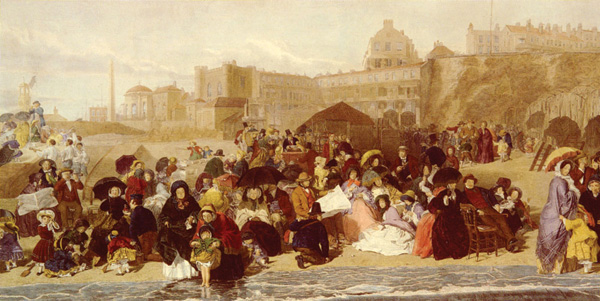
When a British dealer learned that Queen Victoria was interested in William Powell Frith's "Life at the Seaside," above, the dealer sold it to the queen at cost but retained the exhibition and engraving rights, which the dealer subsequently sold for a £3,000 profit.
By John R. Page, associate professor of accounting
A recent investigative article in the Wall Street Journal discussed in some detail the operation of the famous contemporary “uber-art dealer” Larry Gagosian. The author, Kelly Crow, describes an international network of galleries and connections managed to run in tandem to effect virtual control of a market segment: Gagosian’s stable of artists. Far-flung and apparently with deep pockets, this network can propel artists to instant international fame with corresponding impact on price levels. Savvy collectors are de-facto partners in this network as the dealer’s preferred clients, able to “get in” early. The art market’s need for constant renewal makes fame brief and timing critical.
While all this might sound like 21st century Wall Street-style art dealing, nothing could be further from the truth. Research into past art markets has revealed the existence of sophisticated dealer networks in the 19th century and possibly even earlier.
As soon as the art market changed from functioning on the basis of direct contact between patron/buyer and artist/producer to an exchange mechanism that revolved around professional middlemen, networking developed. My colleague Thomas Bayer and I were initially struck by the frequency at which dealers bought painting at auction that had been consigned by other dealers. In the art world of 18th and 19th century London, dealers knew each other and their respective inventory personally. Why would they have chosen to incur additional transaction costs when they could have acquired the work directly? We also noticed that dealers paid on average more for their auction purchases than the rest of the buyers. Does such behavior not present a barrier to the arbitrage opportunities on which the trade depends? However, once we reconstructed the respective inventories each dealer had bought at auction, it became clear that these transactions were meant to support and boost the value of existing stock and send price signals to the market. Art auctions had become popular social and media events, and the trade took advantage of the inherent opportunities.
Further analyses of a specific dealer’s transaction records identified an extensive dealer network whose members collaborated to maximize their role as the art market’s hub. Specific dealers, for instance, bought works directly from certain artists in such numbers that it must have amounted to their entire production. These paintings were then quickly and regularly sold at small profits—more like a handling fee—to other members of this network who would then attempt to retail them directly to the public or, if unsuccessful, recycle them back into the network to give another member an opportunity. Our dealer bought as much from the network’s members as he sold to them. His auction activity, furthermore, showed that he used these trading platforms to signal price levels for the works of his “stable” of painters.
All this created an unstoppable art marketing machine that propelled artists to hitherto unknown levels of fame and fortune and made dealers into the princes of the art world.
Clearly, uber-art dealing has quite a pedigree.
John R. Page is co-author of The Development of the Art Market in England: Money as Muse, 1730-1900, published in March 2011 by Pickering and Chatto. The book, co-authored with Thomas M. Bayer, adjunct lecturer of art history, traces the growth of the modern art markets through an analysis of more than 42,000 art sales at British auction houses.


